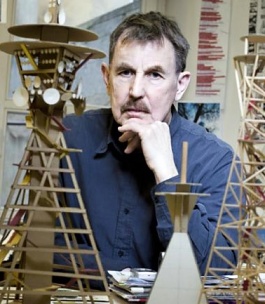
The architect Vlado Milunić has died
 |
Vlado Milunić became known to the public and the history of architecture primarily for the Dancing House, which he designed together with Canadian-American architect Frank Gehry. He was also recognized for his views on the design of Prague’s housing estates and as a co-author of several social buildings. A native of Croatia, who lived in the Czech Republic since his teenage years, according to Czech Radio Radiožurnál, died at the age of 81.
Milunić's most famous work – the Dancing House on Rašínovo nábřeží in Prague – was built in the mid-1990s. The building, which provoked many negative reactions, became one of the symbols of Prague and is reportedly the third most photographed object in the city, after Charles Bridge and Hradčany. The administrative building, nicknamed Ginger and Fred for its "dancing" silhouette, received numerous awards, including "The Best Design Of 1996" from the American magazine Time.
On the site of the Dancing House stood a residential building that was accidentally destroyed by an American bomb during the air raid on Prague in February 1945. In 1963, a decision was made to develop the vacant lot, but for a long time, nothing was done. Then architect Milunić entered the scene, who proposed a division of the apartment to Václav Havel, who lived in the neighboring building: "At the time, we discussed what kind of house could stand next to it. It was supposed to be a house full of culture. I wanted the house to lean over the intersection, as it was to personify the state of Czechoslovak society, which was beginning to move out of totalitarian rigidity. That is why I wanted a static, motionless tower at the back and a dynamic part of the building in the foreground that moved over the intersection. Just like society, where its smaller part separated from the larger, statically totalitarian part and set out into a world of change. That is the main idea of the dialogue between the two parts," Milunić recalled in the press.
He attributed the opportunity to implement such a modern building in Prague to the post-revolutionary euphoria, then-president Václav Havel, then-director of the preservationists Věra Millerová, and a rare combination of coincidences. The Dancing House was opened to the public on October 1, 1996.
"Ginger and Fred" is now one of the symbols of the metropolis and a tourist magnet: "I am very sorry that the built house is now full of inaccessible offices with an expensive restaurant on the top floor and is not a house of culture accessible to everyone," Milunić stated in the book Dancing House, published by the publishing house Zlatý řez in 2003.
Another significant undertaking by Milunić was the Hvězda residential complex in the Petřiny housing estate in Prague. This atypical colorful housing estate is appreciated by many experts as a typical contrast to gray concrete housing estates. The "humanization" of panel housing estates was one of Milunić's frequent themes. "It is necessary to build new buildings on the free spaces between the panel houses, create winter gardens, and build rooftop extensions. But it is essential that different architects work on each part of the housing estate to avoid monotony," he said about it. An example of his vision of how a housing estate should look is the project for the Malešice housing estate center, which, however, was not realized.
Milunić's work was by no means limited to large projects that attract media interest. For example, in the 1970s and 1980s, mainly in collaboration with architect Jan Línek, he implemented several social buildings in Prague – retirement homes in Bohnice, Malešice, Chodov, and Háje, a hostel for sisters in Prosek, and later, for example, the House of Children and Youth in Modřany.
And he did not limit himself to Prague or the Czech Republic. According to his project, for example, an atypical villa was built in Planá nad Lužnicí in South Bohemia. "The design was born from theft. I stole from Frank Lloyd Wright, my friend Frank Gehry, and Bruce Goff," Milunić admitted once about being inspired by the greatest architects in the world. Abroad, he participated, for example, in the creation of the so-called Czech Quarter in Shanghai, China.
Milunić was also a frequent critic of corruption, clientelism, and other maladies, not only in architecture. He was also well known for his rejection of the construction of high-rise buildings in Prague. "The new high-rise buildings in Pankrác contradict how the capital is composed," he said in one of the interviews.
Vlado (Vladimir) Milunić was born on March 3, 1941, in Zagreb. He lived in Prague from the age of 16, when his parents moved there from what was then Yugoslavia. From 1960 to 1966, he studied architecture at the Czech Technical University in Prague. He then worked for three years in Paris. From 1969 to 1990, he worked in Prague studios Gama and Delta. Since 1990, he has had his own Studio VM (Free Ideas).
In 1998, Milunić was one of 11 personalities honored by the Prague City Hall on the occasion of the 80th anniversary of the founding of the republic. Silver medals were awarded to personalities who had contributed to the international fame of Prague.
The English translation is powered by AI tool. Switch to Czech to view the original text source.
2 comments
add comment
Subject
Author
Date
Čest a sláva
Vích
17.09.22 07:19
Sbohem
Mirko Baum
22.09.22 10:43
show all comments












